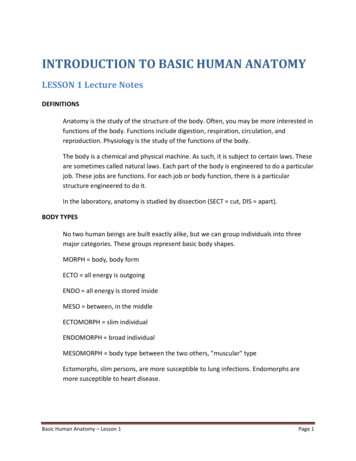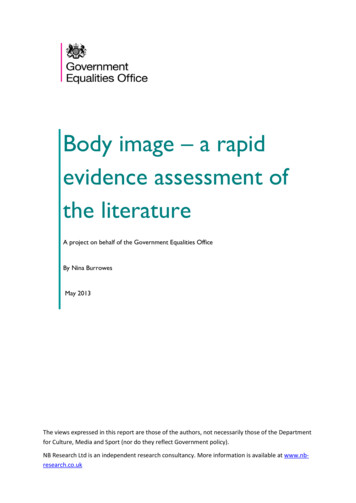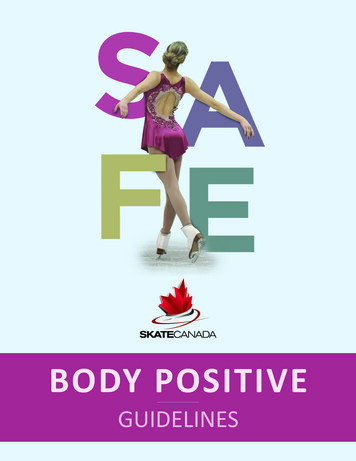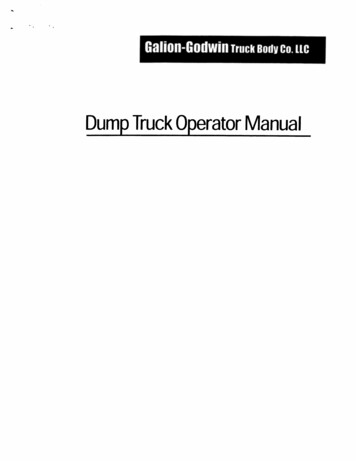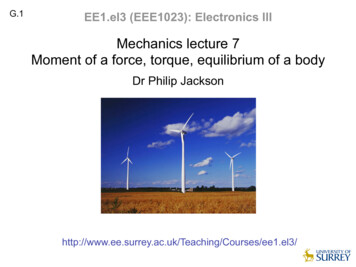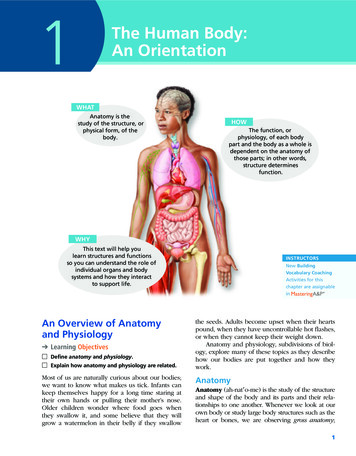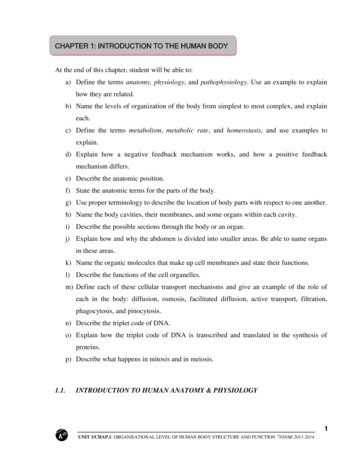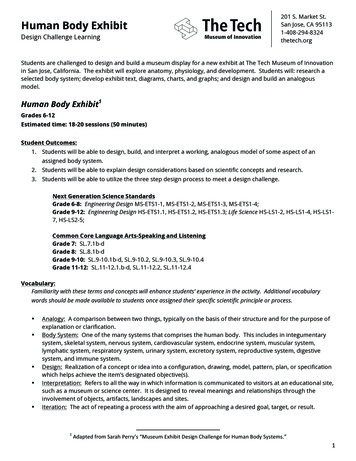
Transcription
201 S. Market St.San Jose, CA 951131-408-294-8324thetech.orgHuman Body ExhibitDesign Challenge LearningStudents are challenged to design and build a museum display for a new exhibit at The Tech Museum of Innovationin San Jose, California. The exhibit will explore anatomy, physiology, and development. Students will: research aselected body system; develop exhibit text, diagrams, charts, and graphs; and design and build an analogousmodel.Human Body Exhibit1Grades 6-12Estimated time: 18-20 sessions (50 minutes)Student Outcomes:1. Students will be able to design, build, and interpret a working, analogous model of some aspect of anassigned body system.2. Students will be able to explain design considerations based on scientific concepts and research.3. Students will be able to utilize the three step design process to meet a design challenge.Next Generation Science StandardsGrade 6-8: Engineering Design MS-ETS1-1, MS-ETS1-2, MS-ETS1-3, MS-ETS1-4;Grade 9-12: Engineering Design HS-ETS1.1, HS-ETS1.2, HS-ETS1.3; Life Science HS-LS1-2, HS-LS1-4, HS-LS17, HS-LS2-5;Common Core Language Arts-Speaking and ListeningGrade 7: SL.7.1b-dGrade 8: SL.8.1b-dGrade 9-10: SL.9-10.1b-d, SL.9-10.2, SL.9-10.3, SL.9-10.4Grade 11-12: SL.11-12.1.b-d, SL.11-12.2, SL.11-12.4Vocabulary:Familiarity with these terms and concepts will enhance students’ experience in the activity. Additional vocabularywords should be made available to students once assigned their specific scientific principle or process. Analogy: A comparison between two things, typically on the basis of their structure and for the purpose ofexplanation or clarification.Body System: One of the many systems that comprises the human body. This includes in integumentarysystem, skeletal system, nervous system, cardiovascular system, endocrine system, muscular system,lymphatic system, respiratory system, urinary system, excretory system, reproductive system, digestivesystem, and immune system.Design: Realization of a concept or idea into a configuration, drawing, model, pattern, plan, or specificationwhich helps achieve the item’s designated objective(s).Interpretation: Refers to all the way in which information is communicated to visitors at an educational site,such as a museum or science center. It is designed to reveal meanings and relationships through theinvolvement of objects, artifacts, landscapes and sites.Iteration: The act of repeating a process with the aim of approaching a desired goal, target, or esignChallengeforHumanBodySystems.”1
201 S. Market St.San Jose, CA 951131-408-294-8324thetech.orgHuman Body ExhibitDesign Challenge Learning Label: a caption describing an object exhibited in a museum, or one introducing a room, area, or the wholemuseum.Model: A three-dimensional representation of something, typically on a smaller scale than the original –something used as an example to follow or imitate.Basic Project TimelineSession 1 Introduce the challenge and general project outline.Session 2 Choose teams and assign topics.Have teams establish team expectations by which togovern their project.Teams begin researching topics individually. Session 3-4 Session 5 Session 6-10 Provide the framework for Brainstorming and TeamPlanning.Teams continue to research their topics.Introduce principles of good exhibit design and creatinglabels.Teams engage in a mini design challenge of creating alabel for an everyday object.Teams submit their initial design concept for approval.Set expectations for the building period and go oversafety instructions for tool use.Teams build their analogous model and exhibit display.Session 11 Teams engage in a design review and rehash their teamplan based on the information gathered.Session 12-15 Provide background on museum interpretation.Teams continue to refine their exhibits and analogousmodels.By the end of session 15 all exhibits and guides should becomplete. Session 16-17 Exhibit walk – teams demonstrate and engage others intheir exhibits.Session 18 Closing discussion on the project and evaluation ofteams.2
201 S. Market St.San Jose, CA 951131-408-294-8324thetech.orgHuman Body ExhibitDesign Challenge LearningResources:Design Stanford D.School: A Stanford University program that is a hub for innovators of all backgrounds tocome together to solve problems. Their website provides a Virtual Crash Course in their DesignThinking methodology, including a video, facilitation guide, materials list, and supporting documents.They emphasize that “NO PREVIOUS DESIGN EXPERIENCE IS REQUIRED.”http://dschool.stanford.edu/dgift/ Dieter Rams and Good Design: A website about the company Vitsoe, it provides background on theinfluential industrial designer Dieter Rams (b.1932) and his philosophy on “Good ams PRINT SOURCE: The Non-Designer’s Design Book by Robin Williams: A quick, non-intimidating, andexcellent resource on the design principles that govern good designs. The book is humor-infused,jargon-free, and includes design exercises, quizzes, and illustrations.Analogies and Education “The Use of Analogy in Physics Learning and Instruction”: A paper prepared by Noah Podolefsky at theUniversity of Colorado. It provides research on the theoretical framework describing analogy as well asthe strategies for using nIssues/podolefsky/research/podolefsky analogy physics.pdf Teaching and Learning with Analogies: An excerpt from pages 11-24 of P.J. Aubusson et al. (eds.)’s bookMetaphor and Analogy in Science Education printed in 2006 by Springer in the Netherlands. The excerptprovides an understanding of the benefits and common pitfalls of teaching science through doc/professor attachments/Harrison-Treagust06.pdfMuseum Exhibits and Interpretation A guide that provides suggestions for exhibit design. The guide was developed for National History DayExhibits, but contains information on good exhibition design that reaches across disciplines. There isalso an example of an exhibit design handout where students can plan their exhibit layout.http://www.ncdcr.gov/Portals/32/PDF/guide exhibit.pdfAn exhibit design and development workbook designed for the Texas Historical Commission. It is acomprehensive source on all aspects of designing a museum df3
201 S. Market St.San Jose, CA 951131-408-294-8324thetech.orgHuman Body ExhibitDesign Challenge LearningDesign Challenge Process:The Design Challenge Process is designed so students reinforce their science, mathematics, social studies, andlanguage arts content knowledge, through an open-ended process that results in an original, team-driven solution.Students are expected to take responsibility for assessing their own progress and incorporate peer feedback as theyconceptualize and redesign their projects.The process consists of three interconnected steps:Conceptualize Identify problem, materials, and constraints Brainstorm ideas and possible solutionsConstruct and Test Select a solution Design and construct Prototype Redesign or modify RetestAcquire Knowledge Research Share solutions Reflect and discussThrough the try, fail, learn approach, students develop the skills and habits of mind of Silicon Valley innovators:creativity, problem solving, design, collaboration, leadership, risk-taking, perseverance, and learning from failure.Materials:Materials can be limiting or inspirational to students! Have a wide variety of materials to promote a diversity ofsolutions. “Recycled items” are really useful: old mouse pads, wood scraps, boxes, cardboard tubes, strawberrybaskets, etc.Class Supplies to Share: Art andConstructionSupplies (No prebuilt models) Computers withInternet Access Science Texts Research Materials Grumbacher ColorComputerSuggested Art and Construction Supplies:For San Francisco Bay Area teachers, plan a visit to RAFT (Resource Area for Teaching) where you can pick-up bulkart, construction, and recycled materials. www.raft.net Hot Glue Nuts and Bolts White Glue Craft Sticks Wood Glue Doweling Tape (masking, Wood Piecesscotch, painters,(variety of sizes)etc.) General Office ScrewsSupplies Nails4
201 S. Market St.San Jose, CA 951131-408-294-8324thetech.orgHuman Body SystemDesign Challenge LearningLesson Plan:Session 1: Introduce the Challenge (50 minutes)1. Scenario: The Tech Museum of Innovation in San Jose, California is building a new exhibit and needsideas for new, interactive displays. The exhibit is an exploration of anatomy, physiology, anddevelopment. In order to make the exhibit accessible to individuals with little-to-no science knowledge,they would like the displays to include interactive and hands-on analogous models.2. Challenge: Design and create a museum exhibit/display that includes labels, an analogousdevice/model, and an exhibit interpretation guide based on an assigned human body system.3. Constraints: Your device must have at least one (1) moveable part and be able to withstand repeated butgentle use by other students. You must make a drawing of your device and have it approved by the instructor before you startto build. No pre-built parts or devices may be utilized. You must include a display board or partitioning device to display information and keep yourdisplay separate from others. Display must fit in a 2.5’ x 2’ space. All pictures and information must be appropriately cited. Everyone on the team must contribute to the exhibit/display. All labels must be original work. No plagiarism.4. Building Information: Design teams will be responsible for delivering their initial exhibit concept onsession 5, a concept review on session 11, and their final product on session 16 for the opening of theexhibit. Teams will have a total of fifteen 50 minute sessions to research, design, build, test, and iteratetheir exhibit designs. During this time teams will be responsible for governing their own projects butmay go to the instructor for input or mediation assistance. See the Timeline in “Additional Materials” for abreakdown of the project.5. Demonstration Information: Design teams will be expected to serve as interpreters for their exhibit onopening day. They will be expected to not only demonstrate their exhibit, but also engage visitors(fellow classmates) in meaningful conversations about their exhibit. This conversation should not beone-sided, and exhibit interpreters should be asking the visitors open-ended questions to help meetspecific learning outcomes designated by the instructor.6. Analogous Models: Define an analogous model as making a comparison of two things that are topicallyunrelated, but whose structures are similar. Utilizing an already understood item or system to describesomething unknown can help people understand new ideas and concepts. Present examples ofanalogies such as: “Life is like a box of chocolate”: https://www.youtube.com/watch?v CJh59vZ8ccc “Ogres are like onions”: https://www.youtube.com/watch?v bMcXVe8zIs Analogy of the Hunger Games to a Cell: https://www.youtube.com/watch?v Xo9L2FB7aDo7. Field General Questions: The instructor should leave time at the end of the discussion for questions.The instructor may encourage students to write questions on a 3x5 card and hand the cards in for theinstructor to run through at the end of the session. These questions and answers can then be postedfor all teams to reference as the project progresses.Session 2: Teams, Topics, and Planning (50 minutes)1. Choose Teams and Assign Topics: The instructor can pre-assign teams and topics, allow students tochoose their own teams and topics, or use any other manner to ensure that teams are even and topicsare not repeated. Following are some interactive ways to assign teams and topics:5
201 S. Market St.San Jose, CA 951131-408-294-8324thetech.orgHuman Body SystemDesign Challenge LearningPlaying Cards: Assign teams by shuffling a deck of playing cards and passing the cards out. Prestack the deck for only the number of students you have. Students with the same face becometeam mates. Steal the Bacon: Have teams face off for their preferred topics. Use a basketball court and placethe “bacon” (any non-breakable object) in the center. Teams line up on the short edges. Acontent-based question is asked. One member from each team runs to the center to be the firstto “steal the bacon.” The first person to steal the bacon gets three seconds to answer thequestion; if they answer correctly they get to choose their topic. Image Puzzles: Take an image of each of the systems and cut it into the number of people perteam. Pass out the pieces randomly and have students find their partners and discover theirtopic by putting the pieces of the image together.2. Establish Team Expectations: Have teams meet for no more than 20 minutes to prepare a set ofexpectations for their team as they proceed through the project. The instructor should give a brief – nomore than 5 minutes – presentation on team management to help the students get started. See“Additional Materials” for a suggested team contract.3. Introductory Research: Once teams are assigned, they should use the remainder of their time toindividually begin the research phase of their project. They should have access to research materialsincluding class texts, scholarly online resources, and a variety of other informational media (podcasts,videos, books, journals, images, etc.). Encourage students to answer questions in their text, recordinteresting facts, write down additional questions they had, and take note of any connections they madeas they read. Session 3-4: (50 minutes each)1. Brainstorming: Review brainstorming guidelines with students. Instructor should emphasize thatbrainstorming is a period where ideas are shared – there should be no discussion until after all ideashave been presented. See “Additional Materials” for a hand out on brainstorming. Give teams 10-15 minutes to brainstorm all their ideas for their project. Encourage them tostand up, draw pictures, use hand movements, write, talk, and post all of their ideas. You canfurther challenge your students by requiring each person or each team to develop a specificnumber of ideas. Once brainstorming is complete, teams should then go through and discuss their ideas andnarrow their ideas to the top three. These three ideas will later be narrowed down to their topidea. Encourage students to pursue multiple avenues until session five, when all information willbe shared and building will begin.2. Team Planning: One of the most important parts of any project is developing a plan that will help guidethe team to completion. What are important aspects to include in a plan? The instructor should haveexamples of project plans to share with the students. The team should review and revise the teamplan at the start and end of each meeting – a plan is not a rigid document and should be changed. See“Additional Materials” for team planning form. Teams should be given about 20 minutes to put together a basic team plan. This should includeidentifying tasks, assigning perceived/planned tasks, creating team rules and expectations, andputting together a project time-line. Teams should refer to their contract from session two as they put together the team plan.3.Team Research: Teams should begin discussing the information they learned from their introductoryresearch. They should share: answers to the questions in the book, interesting facts, questions theyhad, and interesting connections they made. From the discussion, teams should begin to assembleand group information for their exhibit, dig further into certain aspects of their research, and adjusttheir team plan.6
201 S. Market St.San Jose, CA 951131-408-294-8324thetech.orgHuman Body SystemDesign Challenge LearningSession 5: (50 minutes)1.Exhibit Design: Introduce a few basic principles of exhibit design: contrast, repetition, alignment, andproximity, to help students with their layouts. Give examples of good and poor designs and havestudents critique them as a class.2.Labels: A museum label is a caption describing an object exhibited, or a bulk of text that introduces aroom, area, exhibit, or whole museum. Three golden rules: (1) Be as brief as possible; (2) Make a point; (3) Use accessible language Three perspectives to consider: (1) Content; (2) Style; (3) Design Key themes:o Big Idea: this is not a topic, but what one says about them. It provides focus for both thevisitor and the exhibition team. Always relate your exhibit pieces back to the big idea –what does this have to do with the big idea?o Objects and Audience: How are you going to grab the audience’s attention? How areyou going to hold their attention? How long are they willing to give you their attention?o Messages and Meaning: Create ‘revelation through information’ (Freeman Tilden). Don’tdescribe; tell a story – but don’t write a book. Create a pyramid that works from thecrucial to the not-so-crucial and identify the information with different fonts, bullets,bolding, etc. An analogy for the exhibit visitor: paddlers, swimmers, and divers. Mini team challenge: Write a label to make an everyday object interesting, but you may only use75 words or less.3.Review of Initial Exhibit Concept: By the end of the fifth session teams should turn in an explanationof their exhibit concept. They should state their analogy, describe the analogy, and explain how theirexhibit will be interactive or what moveable pieces their exhibit will have. They should also include a“budget” – a list of their anticipated materials – and their project plan for session six and onward.Session 6-10: (50 minutes each)1.Expectations for Building: Sessions six through ten will be geared toward the creation of the exhibit.Instructors should introduce their basic expectations during this process, such as: All members of the team must be actively involved in some aspect of the exhibit buildingprocess including the creation of the model, display of the information, creation of labels, etc. All work spaces must be clean by the end of each session and all materials must be stored inappropriate locations. Only take those materials and tools that are going to be actively used. When something is notbeing used return it to the table for other teams. Exercise safety when utilizing all tools and take appropriate safety measures where necessary –gloves, goggles, etc.2.Safety Introduction: If you provide wood-working tools, or tools that require a specific safety protocolintroduce this at the beginning of session six. You may need to explain to groups how to use specifictools such as: miter box and saw, drills and drill bits, awls, knives, and other sharp tools. If youprovide your students with wood, pipe, and other heavy construction materials make sure theappropriate tools are available. Additional parent volunteers are suggested if allowing students toutilize wood-working tools.3.Instructor’s Role: During sessions 6-10 the instructor should be available for questions and mediation.The role of the instructor should be to guide students through leading questions and suggestedresources. Instructors should reiterate that teams should revisit their plan at the start and end ofeach session.7
201 S. Market St.San Jose, CA 951131-408-294-8324thetech.orgHuman Body SystemDesign Challenge LearningSession 11: (50 minutes)1.Concept Review: Each group will lay out their display in the assigned location and groups will beassigned to review up to three exhibits. Reviews should take place as short discussion sessions lastingno more than five minutes. The reviewing teams should ask questions, test working parts, and offer atleast two “stars” and one “wish”. “Stars” are things that the reviewers like about the current exhibit, a“wish” is something the reviewers would like to see added, changed, or subtracted. The “stars” and“wishes” can be written down and left for the reviewees to read at the completion of the session.2.Team planning: Provide about 20 minutes at the end of the session for teams to regroup and go overthe notes left by other teams. They should discuss the notes and incorporate new ideas and conceptsinto their plan. Teams should be encouraged to also reflect on the teams that they reviewed, andborrow ideas that they liked.Session 12-15: (50 minutes each)1.Interpretation: Interpretation is how museums help visitors make sense of exhibits. Interpretation isa story, it is factual, and it is always a conversation. Therefore, interpretation guides need to providefactual information on the concepts and principles being presented, the story of the key message ofthe exhibit, and suggested questions to help engage visitors. See “Additional Materials” for a forminterpretation guide.2.Refinement: During the final four sessions teams should refine their exhibits, complete all pieces oftheir display and assemble everything. By the close of session 15 teams should be completely finishedwith their exhibit.3.Instructor’s Role: During sessions 12-15 the instructor should be available for questions andmediation. The role of the instructor should be to guide students through leading questions andsuggested resources. Instructors should reiterate that teams should revisit their plan at the start andend of each session.Session 16-17: (50 minutes each)1.Exhibit Walk: Teams should be given about 10 minutes to complete any last minute set-up of theirexhibit – it should not include building, but just adjustments and team planning for the interpretation.Each team should split into pairs with one pair visiting exhibits and the other remaining at their exhibitto interpret. The pairs will switch during the second session to allow all team members theopportunity to experience the exhibits and interpret.2.Exhibit Walk Expectations: The instructor should set expectations for the individuals completing theexhibit walk including time spent at each exhibit, systematic gathering of information, a review ofother teams’ exhibits, etc.3.Evaluation: The Exhibit Walk period will give the instructor the opportunity to evaluate the teams onthe criteria of the project. See “Additional Materials” for a suggested rubric and scoring system.Session 18: (50 minutes)1. Discussion: Engage the class in a discussion of their experience and knowledge acquired regardingscientific concepts, designing, team dynamics, and project planning.2. Evaluation: Teams should be given an opportunity to review themselves, their teams, and their teammembers. Provide a rubric that allows each student to review these aspects of the project and aspace to reflect on the experience. See “Additional Materials” for suggested formats for both a rubric anda self-assessment.8
201 S. Market St.San Jose, CA 951131-408-294-8324thetech.orgHuman Body SystemDesign Challenge LearningAdditional Materials9
201 S. Market St.San Jose, CA 951131-408-294-8324thetech.orgHuman Body SystemDesign Challenge LearningPROJECT OVERVIEWAnalogous Model Museum Exhibit Design ChallengeSCENARIO:The Tech Museum of Innovation in San Jose, California is building a new exhibit and needs ideas fornew, interactive displays. The exhibit is an exploration of anatomy, physiology, and development. Inorder to make the exhibit accessible to individuals with little-to-no science knowledge, they wouldlike the displays to include interactive and hands-on analogous models.CHALLENGE:Design and build a museum exhibit/display that includes labels, an analogous device/model, and anexhibit interpretation guide based on an assigned human body system.CONSTRAINTS: Your device must have at least one (1) moveable part and be able to withstand repeated butgentle use by other students. You must make a drawing of your device and have it approved by the instructor before you startto build. No pre-built parts or devices may be utilized. You must include a display board or partitioning device to display information and keep yourdisplay separate from others. The display must fit in a 2.5’ x 2’ space. All pictures and information must be appropriately cited. Everyone on the team must contribute to the exhibit/display. All labels must be original work. No plagiarism.MATERIALS AND RESOURCES: Various art and construction supplies from the classroom or from home may be utilized. Nopre-built models are allowed. You will have access to computers with internet resources. You are encouraged to utilize the class science text and other books that you find both insideand outside of class.PROJECT TIMELINE:Session 1Session 2Session 3-4Session 5Session 6-10Session 11Session 12-15Session 16-17Session 18Introduction of ChallengeTeams and Topics Assigned. Establish Team Expectations. Begin Research.Brainstorming and Project Planning. Continue Research.Initial Concept Review Due. Review of Exhibit Design and Labels.Construction of Exhibit.Initial Design Review.Exhibit Interpretation and Refinement of Device. Exhibit Finished Session 15.Exhibit Walk.Closing Discussion and Final Evaluation.10
201 S. Market St.San Jose, CA 951131-408-294-8324thetech.orgHuman Body SystemDesign Challenge LearningSkeletal SystemStudent HandoutVOCABULARY: Skeletal systemCompact boneSpongy boneCartilage JointLigamentMechanical advantageOBJECTIVES:1.2.3.4.5.Identify the major organs of the skeletal system.Describe the functions of bones.Illustrate the internal structure of bones.Compare (and contrast) 3 types of joints.Discuss how bones function as levers.STANDARDS:1. The anatomy and physiology of plants and animals illustrate the complementary nature of structure andfunction. Students know:a. Plants and animals have levels of organization for structure and function, including cells, tissues, organs,organ systems, and the whole organism.b. Organ systems function because of the contributions of individual organs, tissues, and cells. The failureof any part can affect the entire system.c. How bones and muscles work together to provide a structural framework for movement.2. Physical principles underlie biological structures and functions. Students know:a. How to compare joints in the body (wrist, shoulder, thigh) with structures used in machines and simpledevices (hinge, ball-and-socket, and sliding joints).b. How levers confer mechanical advantage and how the application of this principle applies to themusculoskeletal system.3. Scientific progress is made by asking meaningful questions and conducting careful investigations.a. Select and use appropriate tools and technology to perform tests and to collect and display data.b. Utilize a variety of print and electronic resources to collect information as evidence as part of a researchproject.c. Communicate the logical connection among hypotheses, science concepts, and tests conducted, datacollected, and conclusions drawn from the scientific evidence.d. Construct scale models, maps, and appropriately labeled diagrams to communicate scientific knowledge.e. Communicate the steps and results from an investigation in written reports and verbal presentations.11
201 S. Market St.San Jose, CA 951131-408-294-8324thetech.orgHuman Body SystemDesign Challenge LearningMuscular SystemStudent HandoutVOCABULARY: Muscular systemSmooth muscleCardiac muscleSkeletal muscle TendonFlexorExtensorOBJECTIVES:1.2.3.4.List the major parts of the muscular system.Describe the different types of muscle.Describe how skeletal muscles move bones.Compare (and contrast) aerobic exercise with resistance exercise.STANDARDS:1. The anatomy and physiology of plants and animals illustrate the complementary nature of structure andfunction. Students know:a. Plants and animals have levels of organization for structure and function, including cells, tissues, organs,organ systems, and the whole organism.b. Organ systems function because of the contributions of individual organs, tissues, and cells. The failureof any part can affect the entire system.c. How bones and muscles work together to provide a structural framework for movement.2. Scientific progress is made by asking meaningful questions and conducting careful investigations.a. Select and use appropriate tools and technology to perform tests and to collect and display data.b. Utilize a variety of print and electronic resources to collect information as evidence as part of a researchproject.c. Communicate the logical connection among hypotheses, science concepts, and tests conducted, datacollected, and conclusions drawn from the scientific evidence.d. Construct scale models, maps, and appropriately labeled diagrams to communicate scientific knowledge.e. Communicate the steps and results from an investigation in written reports and verbal presentations.12
201 S. Market St.San Jose, CA 951131-408-294-8324thetech.orgHuman Body SystemDesign Challenge LearningIntegumentary SystemStudent HandoutVOCABULARY: Integumentary systemSweat glandsMelanin EpidermisDermisHair follicleOBJECTIVES:1.2.3.4.Describe the major functions of the integumentary system.List the major parts of the skin, and discuss their functions.Describe the structure and function of hair and nails.Describe some common types of damage that can affect skin.STANDARDS:1. The anatomy and physiology of plants and animals illustrate the complementary nature of structure andfunction. Students know:a. Plants and animals have levels of organization for structure and function, including cells, tissues, organs,organ systems, and the whole organism.b. Organ systems function because of the contributions of individual organs, tissues, and cells. The failureof any part can affect the entire system.2. Scientific progress is made by asking meaningful questions and conducting careful investigations.a. S
Human Body Exhibit Design Challenge Learning 1" " 201 S. Market St. San Jose, CA 95113 1-408-294-8324 thetech.org " Students are challenged to design and build a museum display for a new exhibit at The Tech Museum of Innovation in San Jose, California. The exhibit will explore anatomy, physiology, and development. Students will: research a



